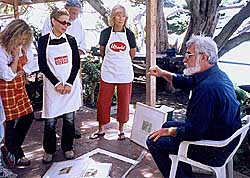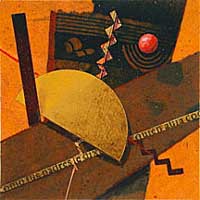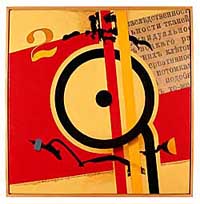|
"The more fully we give our energy, the more it returns to us." Jack Kornfield © 2003 Nita Leland |
| Jonathan Talbot's collages came to my attention when I was searching for illustrations for my book, Creative Collage Techniques (see p. 37). His strong design and color are excellent. I've been told his workshops are great, too. Here's his story "in his own words." |
|
Q. Jonathan, what's your earliest memory of making art? A. My mother, Helen Talbot, was an artist. She received her art degree at Skidmore College and then went on to study in Munich and Frankfort, Germany in the 1920s. She encouraged my childhood artistic efforts by asking me to tell her about my drawings and then writing down everything I told her on the backs of the drawings themselves (this was before I knew how to write). I still have some of those drawings and it appears that my mom was very thorough. The backs of the drawings are often completely covered with lengthy descriptions written in my mother's fine hand. . |
 | |||
| Q. What is your art school background? A. I didn't commit myself to a visual arts career until I was thirty years old. At that time I signed up for "etching 1" at the San Francisco Academy of Art. I also snuck into the San Francisco Art Institute to dip some copper plates since the Academy had no acid baths for copper. That's about it. That one class... No art degrees (or any other degrees for that matter).
Q. Who or What had the greatest influence on you as you developed as an artist?
Q. Why collage?
Q. How do you know when your collage is done? |
| Q. How would you describe your creative process? A. A joyful struggle which yields great satisfaction. |
|||
| Q. What advice do you give students on skills and goals? A. I do not consider the persons who participate in the workshops I lead to be students. Often I learn as much or more from them as they do from me. I consider them colleagues. That said, my feeling about skills is that they are handy and my feeling about goals is that the clearer they are they more likely one is to achieve them.
Q. What can you tell us about your recent experience at the Biennial in Florence, Italy? |
 | ||
|
Thanks, Jonathan, for sharing your work and thoughts with us. Here are Jonathon's email address and web site
|


